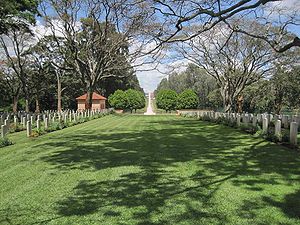Nairobi War Cemetery
| Nairobi War Cemetery | |
|---|---|
 | |
| Country: | Nairobi |
| Coordinates: | |
| Type: | Public |
| Owned by: | Commonwealth War Graves Commission |
| Number of gravesites: | 1,941 |
| Website: | Nairobi War Cemetery |
The Nairobi War Cemetery is a cemetery in Kenya containing graves starting from the Second World War.
History
During the Second World War, Nairobi was the headquarters of the East African Force and the base for the conquest of Jubaland and Italian Somaliland, the liberation of British Somaliland and the sweep north-westwards to open Addis Ababa for the return of the Emperor. It was also a hospital centre; No.87 British General Hospital arrived in June 1943 and was still there in December 1945, while No.150 British General Hospital was there for a period in 1943.
The war cemetery was opened in 1941 by the military authorities. Besides the original burials, numerous graves were transferred to this cemetery from African civil cemeteries and temporary army burial grounds at Garissa, Gelib, Kinangop, Marsabit, Mega and other inaccessible places, so that it is now the largest war cemetery in East Africa.
Nairobi War Cemetery now contains over 2,000 Commonwealth burials of the Second World War, 11 of which are unidentified. There are also 80 non-war burials and one French grave.
Within the cemetery is the East Africa Memorial, which commemorates men of the land forces who lost their lives in the advance from the south into Italian Somaliland and Ethiopia and during the occupation of those territories, and who have no known grave. Along with them are honoured those who died during the operations in Madagascar in 1942 and who have no known grave. Besides those who died in these campaigns, many men who were lost in the sinking of the troopship 'Khedive Ismail' en route to Ceylon on 12 February 1944 are commemorated here; they include a great part of the 301st Field Regiment, East African Artillery.
The cemetery also contains the Nairobi Memorial which commemorates 477 men of the United Kingdom, South African, and East African Forces who died in the non-operational zones of Kenya whilst in training, or on lines of communication or garrison duty, and whose graves could not be located or are so situated as to be unmaintainable.[1]
Location
The War Cemetery is on the south-western outskirts of Nairobi, about 10 kilometres west of the city centre on Ngong Road, which is the main road to the Government Forest Reserve.
The cemetery is adjacent to Nairobi race course and is included within the Ngong Forest Reserve. It is reached by way of a long driveway off Ngong Road, the turning being indicated by a CWGC direction sign.
Nairobi War Cemetery is open every day between 06:00 and 18:00. Note that there have been reported attacks in the vicinity of the cemetery therefore all visitors are strongly advised to take care and not carry any valuables when visiting. Visitors are strongly advised not to walk along the 1km access track to the cemetery from the main road but should travel to the cemetery entrance by vehicle only. (July 2015)
"We Rest Here"
The following Signals related person is buried here.
| Headstone | Service Number | Rank and Name | Grave Location |
|---|---|---|---|
| |
SL27395 | Sgt R.H. Moore | Plot 2 Row J Grave 24 |